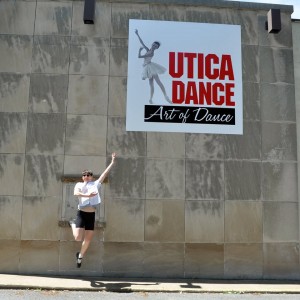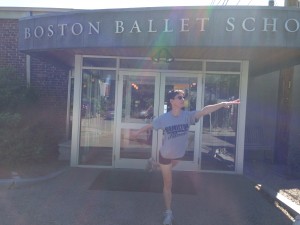
It was about a year ago that I learned of a dance school near me with a class in beginning ballet for adults, and with some trepidation left a voice message inquiring about this class, clarifying that I had no previous experience in dance. I soon got a call back from the director of the school; she assured me that this was something I could do, and answered my questions about clothes for class. My journey soon began with the adult beginner class once a week at MWP Art Institute, then continued in the spring with classes both at MWPAI at Hamilton College. I’m now one week into a two-week program for adults at the Boston Ballet School, and looking forward to another weeklong program for adults in Saratoga Springs.
Along the way I’ve had some revelatory and often emotional experiences, small breakthroughs imperceptible to everyone around me – the first time I found balance without straining, the first time I almost landed a pirouette and could imagine actually getting it, the first time (after half a semester of trying) I got the tombé-pas de bourée-glissade-jeté combination. I’m also acutely aware that many people learn more quickly than I do, or have more natural facility. One goal is to see how successfully one can learn a complex skill in midlife.
I’ve been particularly blessed to have a range of great teachers, with diverse teaching styles but great consistency about the importance of precision in technique. In music often we have one primary teacher for years at a time, but with ballet I have the opportunity to experience these differences in teaching approach and emphasis often within a single week, or even a day. Taking what you can learn from everyone, and building all of that into your own 360º image of ballet technique, is its own creative learning process. I’ve been able to construct a web of different teaching approaches to support my learning that is far stronger and more dynamic than taking just one class.
Proactive learning – taking responsibility for the process, finding learning opportunities, asking fellow students to help you figure something out, looking up videos of a particular step, practicing at home or finding a place to practice on your own, going to some inspiring, world-class performances (Mark Morris, Doug Varone, ABT) – has made this project really mine, a path of growth that – regardless of how quickly I progress or how far I get, ultimately affirms that one is alive and flourishing, not on a long slow decline. Rather than ceding all that bright, shining terrain of learning to youth, this seems at least as important to the project of living well as we get older.
Having said that, I am not settling for ‘oh, you’re taking ballet, good for you!’ Anyone who knows me at all knows that it’s about learning to do something well, about challenging ourselves to excel and to see how good we can get. What are the issues at this one year anniversary?
- There isn’t time to mess around, to indulge mental laziness or self doubt. Determination and tenacity must always be taken up yet another notch.
- Studying the art of ballet is extremely demanding and intricate. You have to understand, in terms of both body mechanics and physics, what is required – what makes it actually work and look beautiful. A super strong core – glutes, abs, thighs, back supporting arms. Everything in alignment and balance, from solid foot placement and correctly working, dynamic turnout on up through knees, hips, torso, shoulders and head. The ability to shift and manage one’s balance, to keep track of and coordinate your entire body while moving and doing multiple things at once. The ability to build and combine basic skills into more complex ones, like a pirouette or a jumping combination. You keep hearing the same corrections over and over – why can’t I get it after the first time (or few times) I hear it? It’s not that easy – the body has to be trained in new habits over time. Constant vigilance in self-monitoring is essential.
- The ability to quickly pick up and retain a combination at the barre, center, or moving across the room is the ultimate test in being present and paying attention. Experience shows it’s better not to imitate in the moment when an exercise is being demonstrated. Instead, focus on recording the precise technique and image into your brain, and trust it to absorb and figure out how to make it work once it’s in your working memory.
- Remembering the steps, thinking ahead, and making the connections fluid is key. This is where I struggle – mentally recording, and strengthening (and exercising) my imagination of what does it feel like to flow and to spring like that, to move through different shapes and to move through space like that? How do you engage with the floor, learn to manage your center of gravity, work with what you’ve got right now in terms of flexibility, strength, and coordination? The capacity to imagine what something that we have not yet done would feel like to do is another level of creative thought; while humans are somewhat similarly constructed, the unique experience each of us has in inhabiting our own bodies requires us to minutely figure these things out for ourselves.
- In other words, the mind and the body alike have to work harder, in a more focused, methodical, and directed way. Grasp the underlying principles to which all of the technique reduces. Find a way to develop your muscle memory.
Those of us who also teach, whenever we find ourselves back on the student side of this process, are particularly attuned to observing through direct experience what is excellent teaching. My list: being present, on, and organized. Finding one’s own way to convey the seriousness of learning in a way that is both authentic and inspiring. Precision and meticulousness. Not giving up on your students – pushing them to go past themselves, giving them that chance. Being mindful of one’s role in the learning process, viewing it from both sides – what do both effective teaching and learning require?
This year marker is a good moment to thank all my teachers this past year – in Utica, Lynn Bollana; at Hamilton, Sandra Stanton-Cotter; in Boston: Helena Froelich, Christopher Hird, Kristin Beckwith, Chris Anderson. And a special reverence to the person who returned that first phone call, and who continues to mentor me in this path – Nancy Long. It is my clear intention to work with energy and dedication with what they have given me – toward growing as a dancer, as well as in translating this into my own musicianship, conducting, and teaching, and in skillfulness at being a good human animal at all times.

Hi Heather, I’m glad to find you! I enjoyed dancing and hanging with you in Saratoga, and I’ve been putting together my thoughts about the experience to share with my friends. I hope you’re feeling good in your dance recovery. I have taken it easy and plan to return to class tonight. I would love to stay in touch with you! Keep dancing!